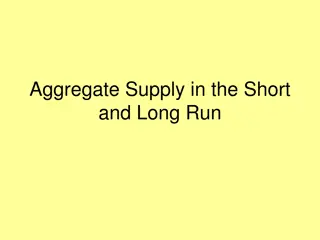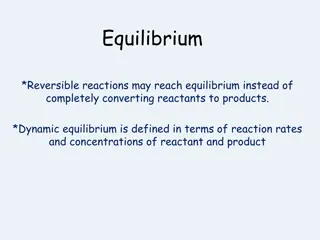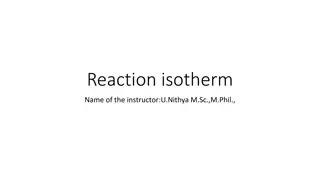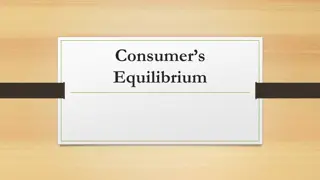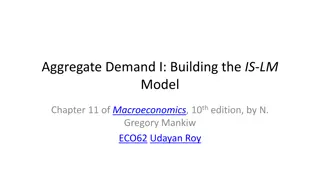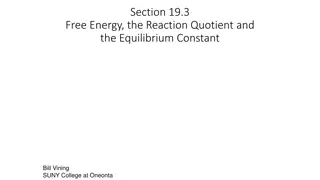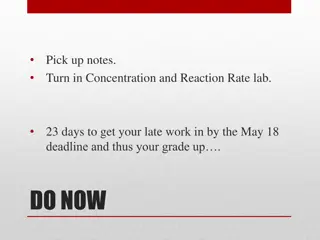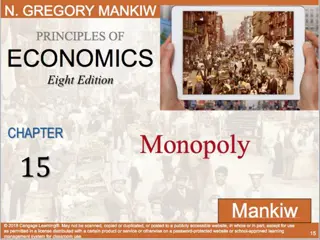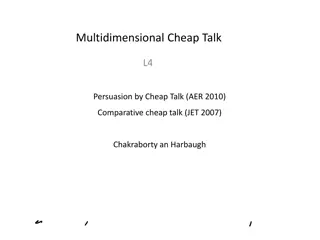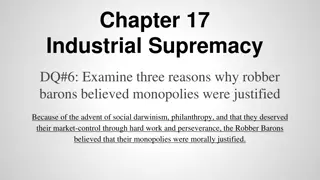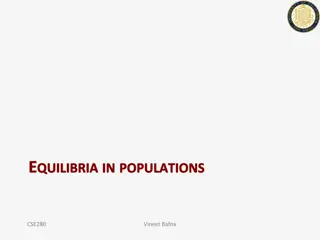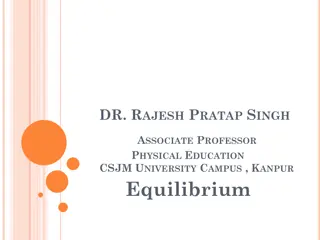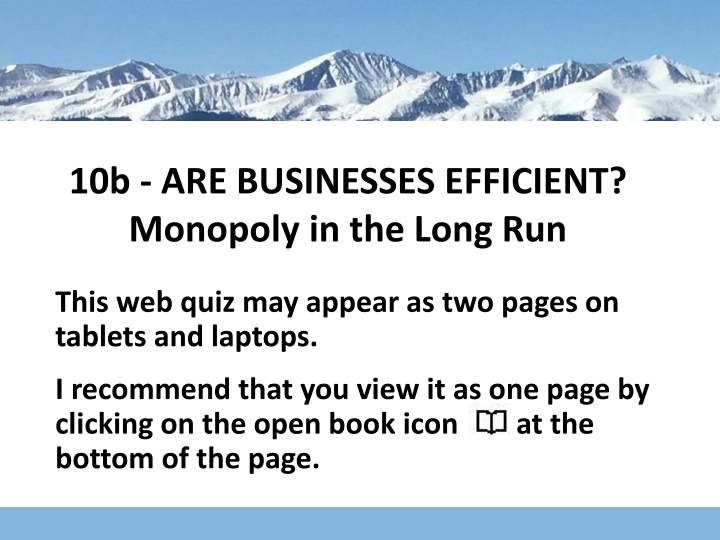
Efficiency of Monopolies in Long-Run Equilibrium
Explore the economic impacts of pure monopolies on prices, production quantity, efficiency, income distribution, and technological progress. Understand price discrimination, regulation dilemmas, and why monopolies persist despite inefficiencies. Gain insights into monopoly key terms and strategies for achieving economic efficiency.
Download Presentation

Please find below an Image/Link to download the presentation.
The content on the website is provided AS IS for your information and personal use only. It may not be sold, licensed, or shared on other websites without obtaining consent from the author. If you encounter any issues during the download, it is possible that the publisher has removed the file from their server.
You are allowed to download the files provided on this website for personal or commercial use, subject to the condition that they are used lawfully. All files are the property of their respective owners.
The content on the website is provided AS IS for your information and personal use only. It may not be sold, licensed, or shared on other websites without obtaining consent from the author.
E N D
Presentation Transcript
10b - ARE BUSINESSES EFFICIENT? Monopoly in the Long Run This web quiz may appear as two pages on tablets and laptops. I recommend that you view it as one page by clicking on the open book icon at the bottom of the page.
ARE BUSINESSES EFFICIENT? 10b Monopoly: Long-Run Equilibrium Long Run Equilibrium and Efficiency Price Discrimination Natural Monopolies and Regulation
10b -- Must Know/Outcomes: Discuss the economic effects of pure monopoly on price, quantity of product produced, allocative and productive efficiency, distribution of income, and technological progress. Understand the adjustment process from the short run to the long run and the role of barriers to entry Why does a monopoly earn economic profits in the long run? Draw the long run equilibrium graph for a pure monopoly and indicate the profit maximizing quantity, the allocatively efficient quantity, and the productively efficient quantity. Define price discrimination, list three conditions necessary for price discrimination, explain how price discrimination affects allocative efficiency, explain why profits and output will be higher for a discriminating monopoly. We know that single price monopolies are allocatively inefficient in the long run. What happens to allocative efficiency if the monopoly can price discriminate? Identify two pricing strategies of monopoly regulation and explain the dilemma the regulators face in utilizing these strategies Explain why a regulated monopoly does not have an incentive to reduce costs. Why does the Illinois government allow ComEd to have a monoply on the distribution of electricity in northern Illinois?
10b -- Key Terms: allocative inefficiency, productive inefficiency, deadweight loss, economies of scale, natural monopoly, X-inefficiency, dynamic efficiency, anti-trust policy, price fixing, tying contract, public interest theory of regulation, legal cartel theory of regulation, deregulation, price discrimination, regulated monopoly, natural, monopoly, socially-optimal price (alloc. efficient price), fair-return price (average-cost price)
Remember: If there are no, or low, barriers to entry, then competing firms will earn normal (zero) economic profits (why?) and they will achieve allocative efficiency (or come close). If there is blocked entry, or high barriers, then firms will earn economic profits (why?) and they will be allocatively inefficient. 10b Monopoly: Long-Run Equilibrium
1. Monopolies can earn long run profits because: 1. They produce a unique product 2. They face a downward sloping demand 3. They are price makers (have market power) 4. They have barriers to entry
1. Monopolies can earn long run profits because: 1. They produce a unique product 2. They face a downward sloping demand 3. They are price makers (have market power) 4. They have barriers to entry
No or low barriers: Pure Competition Monopolistic Competition Blocked Entry or high barriers: Monopoly Oligopoly 10b Monopoly: Long-Run Equilibrium
2. In the LR, what quantity will be produced? YP 35 1. M 2. N 3. Q 4. R
2. In the LR, what quantity will be produced? YP 35 1. M 2. N 3. Q 4. R
3. What is the Prod. Eff. Q? YP 35 1. M 2. N 3. Q 4. R
3. What is the Prod. Eff. Q? YP 35 1. M 2. N 3. Q 4. R
4. What is the Alloc. Eff. Q? YP 35 1. N 2. M 3. Q 4. R
4. What is the Alloc. Eff. Q? YP 35 1. N 2. M 3. Q 4. R
ARE MONOPOLIES EFFICIENT? NO! The profit maximizing Quantity is 0M, where MR = MC (WHAT WE GET) The allocatively efficient quantity , 0Q, where P=MC (WHAT WE WANT). P>MC at 0M Also monopolies do not produce at the lowest possible cost. They do not produce the productively efficient quantity where MC = ATC (0N).
Monopoly: LR Equilibrium Dynamic Efficiency? Means? Incentive? X-Inefficiency? Possible? Incentive?
Monopolies are Inefficient BUT, Cost Complications exist: Economies of Scale make some monopolies MORE efficient: Natural Monopolies [more efficient when regulated] Simultaneous (nonrivalrous) Consumption [MORE efficient] Network Effects [MORE efficient] But other factors also affect the inefficiency of monopolies: X-Inefficiency [even LESS efficient] Rent-Seeking Behavior - protecting the monopoly [even LESS efficient] Dynamic Inefficiency - Less Tech. Advances [even LESS efficient] Price Discrimination [MORE efficient] What can be done? Antitrust Laws Regulate Natural Monopolies Creative Destruction
10b Monopoly: Long-Run Equilibrium ARE BUSINESSES EFFICIENT? Long Run Equilibrium Efficiency? Price Discrimination Natural Monopolies and Regulation
PRICE DISCRIMINATION DEFINITION: The selling of a product to different buyers at different prices when the price differences are not justified by differences in cost. EXAMPLES: Who pays more? / Who pays less? 1. ELECTRICITY: heating or lighting? homes or businesses? 2. DOCTORS: insured patients or uninsured? 3. AIR TRAVEL: business travelers or vacationers? 4. MOVIES / SKIING / GOLF: adults or children? 5. RAILROADS: expensive cargo or inexpensive cargo? 6. COUPONS 7. INTERNATIONAL TRADE 8. OTHERS ???? [cars, flea markets] NECESSARY CONDITIONS: 1. Monopoly power ( price maker ) 2. Market segregation: ability to segregate buyers according to their price elasticity of demand [Who pays more? Who pays less?] 3. No resale CONSEQUENCES (graphically) 1. more profits 2. more production = more efficient
5. Which is NOT a necessary condition for price discrimination? 1. Market power 2. Prevent resale 3. Segregate buyers according to their price elasticities of demand 4. The product must be a normal good
5. Which is NOT a necessary condition for price discrimination? 1. Market power 2. Prevent resale 3. Segregate buyers according to their price elasticities of demand 4. The product must be a normal good
6. A price discriminating monopolist charges a higher price to customers who: 1. Have a more elastic demand 2. Have a less elastic demand 3. Have a perfectly elastic demand 4. Have a unit elastic demand
6. A price discriminating monopolist charges a higher price to customers who: 1. Have a more elastic demand 2. Have a less elastic demand 3. Have a perfectly elastic demand 4. Have a unit elastic demand
7.If this firm were a perfectly price discriminating monopolist, what quantity would be produced? YP 39 1. N 2. M 3. Q 4. R
7.If this firm were a perfectly price discriminating monopolist, what quantity would be produced? YP 39 1. N 2. M 3. Q 4. R
PRICE DISCRIM. Profits Quantity: Q SINGLE PRICE Profits Quantity: M ALLOC. EFF. Quantity: Q Note: price Discrimination may be eff. For a perfectly price discriminating monopolist the price (D) is the MR. YP 39
10b Monopoly: Long-Run Equilibrium ARE BUSINESSES EFFICIENT? Long Run Equilibrium Efficiency? Price Discrimination Natural Monopolies and Regulation
Regulated Monopoly Why rate regulation instead of antitrust? Definitions: Antitrust Laws that prohibit anticompetitive business practices such as price fixing, bid rigging, monopolization, and tying contracts. Natural Monopoly An industry in which economies of scale are so great the product can be produced by one firm at a lower average total cost than if the product were produced by more than one firm. Graph of a Natural Monopoly: Demand crosses ATC while ATC is still downward sloping [See Lecture Outline]
Regulated Monopoly Why government gets involved: 1. to improve allocative efficiency: "public interest " The presumption that the purpose of the regulation of an industry is to protect the public (consumers) from abuse of the power possessed by natural monopolies. 2. political reasons: legal cartel theory The hypothesis that some industries seek regulation or want to maintain regulation so they may form or maintain a legal cartel. a. Proponents of this theory contend that regulators guarantee a return to the regulated firms while blocking entry and dividing up the market - activities that would be illegal in unregulated markets. b. Occupational licensing is an example of this theory in certain labor markets. 10b Monopoly: Long-Run Equilibrium
How the government can regulate rates (prices): 1. P = MC: socially optimum price (P2) (allocatively efficient price) a. Achieve allocative efficiency The price of a product which results in the most efficient allocation of an economy's resources and is equal to the marginal cost of the product. (ALLOCATIVE EFFICIENCY) b. Graph: P2 and Q2 c. Results in a LOSS for the firm. In the long run companies will go out of business. d) Government could subsidize or use AC pricing 2. P = ATC: "fair" return price (P1) a. Definition The price of a product which enables its producer to obtain a normal profit and which is equal to the average total cost of producing it. b. Graph: P1 and Q1 c. Still some inefficiency d. But normal profits (no losses) Regulated Monopoly If not regulated this monopoly would charge a price of P3 and produce Q3. This is both allocatively and productively inefficient. 10b Monopoly: Long-Run Equilibrium
8. How can you tell that this is a natural monopoly? YP 37 1. D is greater than MR 2. MR = zero at Q1 3. Demand crosses ATC when ATC is downward sloping 4. MC crosses ATC at the lowest point of the ATC
8. How can you tell that this is a natural monopoly? YP 37 1. D is greater than MR 2. MR = zero at Q1 3. Demand crosses ATC when ATC is downward sloping 4. MC crosses ATC at the lowest point of the ATC
9. If this monopoly was not regulated they would charge a price of: (YP 37) 1. P1 2. P2 3. P3 4. P4
9. If this monopoly was not regulated they would charge a price of: (YP 37) 1. P1 2. P2 3. P3 4. P4
10. If this monopoly was not regulated they would produce ____ and the alloc. Eff Q is ___: (YP 37) 1. Q3, Q1 2. Q3, Q2 3. Q1, Q3 4. Q1, Q2 5. Q2, Q2
10. If this monopoly was not regulated they would produce ____ and the alloc. Eff Q is ___: (YP 37) 1. Q3, Q1 2. Q3, Q2 3. Q1, Q3 4. Q1, Q2 5. Q2, Q2
11. If the government wanted to achieve alloc. eff. they would put a price ceiling at: (YP 37) 1. P1 2. P2 3. P3 4. P4
11. If the government wanted to achieve alloc. eff. they would put a price ceiling at: (YP 37) 1. P1 2. P2 3. P3 4. P4 What is a problem with setting the price to achieve allocative efficiency?
12. If the government uses AC pricing (fair return pricing) they would put a price ceiling at: (YP 37) 1. P1 2. P2 3. P3 4. P4
12. If the government uses AC pricing (fair return pricing) they would put a price ceiling at: (YP 37) 1. P1 2. P2 3. P3 4. P4 Will this price achieve allocative efficiency?


